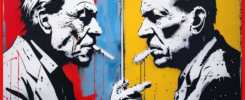My Duel with the Gallerists
When I first immersed myself in the world of AI art, I was both terrified and fascinated. Every day, I experimented with various programs, blending my hand-painted works with AI-generated elements and vice versa. It was a constant challenge to recognize the different painting styles and push artificial intelligence to merge them seamlessly. Each piece I created felt like a new step in an artistic journey that not only challenged my own understanding of art but also tested the boundaries of AI.
Initially, I simply labeled my first five works with numbers, from 01 to 05. When I finally saw them in front of me, held them in my hands, I was thrilled. It wasn’t just me who was impressed—those who saw the results for the first time were equally astonished. Red faces, pale faces, surprised expressions—it was clear that I had created something new, something that touched people. Instantly, I knew that this work needed to mature. I focused on producing purely AI-generated artworks, spending hours crafting the right creative expressions to design each piece, using my knowledge to blend styles ranging from ancient art to modern and even futuristic trends.
was thrilled. It wasn’t just me who was impressed—those who saw the results for the first time were equally astonished. Red faces, pale faces, surprised expressions—it was clear that I had created something new, something that touched people. Instantly, I knew that this work needed to mature. I focused on producing purely AI-generated artworks, spending hours crafting the right creative expressions to design each piece, using my knowledge to blend styles ranging from ancient art to modern and even futuristic trends.
However, my first visits to galleries and gallerists were met with bitter disappointment. Two galleries brusquely dismissed me, stating that AI art wasn’t „real“ art and asking me to leave. Three more followed suit. I was disheartened but also determined. It was obvious that many weren’t yet ready to accept the significance of AI in the art world. After several days, I gathered the courage to visit another gallery, though with a touch of skepticism. When I brought up the subject of AI with the gallerist, she surprised me. She said, „We have 150 paintings in this exhibition, and four of them are created using AI. Can you find the four?“ What a challenge! And one I eagerly accepted.
The gallerist left me to myself, and I began wandering through the gallery, searching for the four AI pieces. The first painting was easy to spot. It depicted a landscape with a building, and I immediately recognized it as AI-generated. The precise detail, created artificially, revealed the technique behind it. One point for me—the first painting was identified.
The second painting proved trickier. It came from the sports genre and was almost indistinguishable as an AI work at first glance. But upon closer inspection, I noticed subtle text imprinted on the painting that hinted it came from the early days of AI art. The style seemed like an attempt to mimic human artists, without fully capturing their organic imperfections. So, the second painting was identified as well.
The third painting was easier again. It portrayed a person, and this piece also came from the early stages of AI development. The somewhat stiff facial features and the way light and shadow were applied left no doubt—it had been created by a machine. With growing confidence, I marked this as the third of the four AI paintings.
Finally, I stood before the fourth and last painting. This one was different from the others, nearly perfect in its execution. The lines were more precise than any human hand or eye could ever achieve. The color transitions were meticulously crafted, with subtle yet powerful nuances. The face of the depicted Japanese woman was flawless, her expression deep and evocative. It was clear that a master of AI art had created this work. Proudly, I declared, „This is number four in your gallery.“
The gallerist returned and smiled, „100 points, you identified them all correctly.“ I could barely contain my pride. It was a moment of triumph, not just for me but for AI art as a whole. Finally, I had proof that AI-generated art could be taken seriously—even by gallerists who had once been skeptical.
This success gave me the confidence to continue refining my art. No gallerist now has any reason to laugh at AI art or dismiss it as inferior. The art world is changing, and I am proud to be part of this revolution, driven by artists like me, Konrad Wulfmeier, and the galleries bold enough to embrace the future.
AI and traditional art are merging into something greater than the sum of their parts—and this is only the beginning.
© 2025 Konrad Wulfmeier | Master Code™ – QuantumNature-Art

